 Erasing
Borders & Erased Preconceptions
- Kiran Rajagopalan
e-mail: kiran.rajagopalan@gmail.com
Photos: www.michaeltoolan.com A unique festival
of Indian dance was recently held in New York City which featured performances,
workshops, panel discussions by artistes based in the US and India. Aptly
titled 'Erasing Borders,' this annual dance festival - now in its second
year - was jointly organized by the Indo-American Arts Council and the
Asia Society. Both organizations consciously included a gamut of Indian
dance styles ranging from traditional and experimental classical to post-modern
and Bollywood. Friday,
June 4
The festival
began with a superb evening of performances by Shipra Mehrotra, Navtej
Johar, Parul Shah Dance Company, Cynthia Lee, and Wanted Ashiqz who presented
pieces in the Odissi, Bharatanatyam, Kathak, Post-modern/Kathak, and Bollywood
styles, respectively. Shipra's opening performance showcased her solid
grounding in tradition and training in Odissi by Dr. Chitra Krishnamurti,
Gangadhar Pradhan, and Aruna Mohanty. She began with the 'Hamsadhwani Pallavi'
choreographed by the late Kelucharan Mohapatra. She then presented Jayadeva's
15th Ashtapadi, "Ramate Yamuna," in which Radha suspiciously imagines Krishna
making love to another woman.
 Shipra
Mehrotra in "Ramate Yamuna"
Shipra
Mehrotra in "Ramate Yamuna"
|
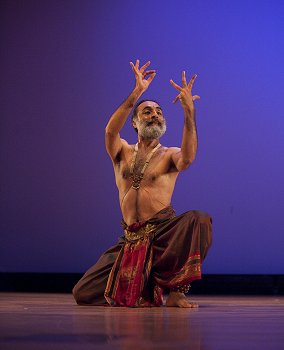 Navtej
Johar in "Meenakhi (The Fish-Eyed Goddess)"
Navtej
Johar in "Meenakhi (The Fish-Eyed Goddess)"
|
Navtej then presented
an excerpt from "Meenakshi (The Fish-Eyed Goddess)" which was choreographed
as a varnam using Muthuswamy Dikshitar's kriti, "Meenakshi
Me Mudam" (Purvikalyani; Adi). The sancharis were embellished with Navtej's
deeply personal touches such as depictions of Meenakshi as a motherly,
sensuous nature goddess. Especially provocative was the image of Meenakhi's
trademark parrot as a representation of her vivacious spirit. Unfortunately,
the music recording was of poor quality, and it was played too softly in
the auditorium.The third performance
was by Parul Shah Dance Company, and they presented an excerpt from 'Samanvay.'
Originally conceived by Kumudini Lakhia and re-choreographed by Parul Shah,
this nritta item was a nice introduction to Kathak dance for the
Asia Society's diverse audience. The subtle costumes, effective lighting,
and superb coordination collectively enhanced the presentation, and these
features also bolstered Parul Shah Dance Company's reputation as one of
America's best classical Indian dance ensembles. The highlight
of the evening was Cynthia Lee's 'Ruddha (Rude, Huh?),' which erased borders
by depicting the friction between dance styles and cultures. Cynthia intelligently
combined Kathak rhythmic bhols and nonsensical English words and
then juxtaposed matching Kathak and American post-modern movements with
them. And the result was a challenging work that was instantly recognizable,
humorous, but cautionary in its message about fusion.
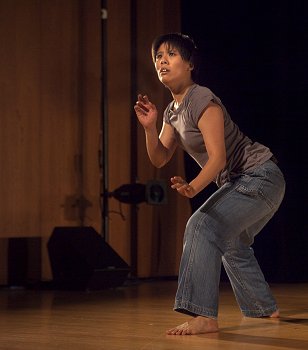 Cynthia
Lee in 'Ruddha (Rude, Huh?)'
Cynthia
Lee in 'Ruddha (Rude, Huh?)'
|
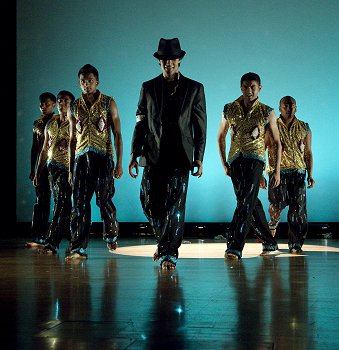 Wanted
Ashiqz in 'Inspired'
Wanted
Ashiqz in 'Inspired'
|
The evening ended
with a lively Bollywood performance by Wanted Ashiqz. This ensemble of
well-trained male dancers showcased various Indian and American pop culture
icons that inspired them to dance such as: Michael Jackson, Madhuri Dixit,
Hrithik Roshan, Govinda, and Beyoncé. Wanted Ashiqz was an apt addition
to the festival because Bollywood is unquestionably a style of Indian dance.
Moreover, Mumbai's film industry has promoted the other forms of traditional
Indian dance in India and abroad.Saturday,
June 5
The second
day began with a workshop, 'Angika: The Dance Body,' which introduced the
basic movements of Bharatanatyam, Odissi, and Kalaripayattu. It was conducted
by Mesma Belsare, Shipra Mehrotra, and Sridhar Shanmugam, and they thoroughly
explained the differences in kinetics of their respective styles to the
largely uninitiated participants. However, the workshop could have been
more effective had each presenter taught at a continuous stretch rather
than in small segments. The next session,
'Vachika: Talking Dance,' was an engaging panel discussion on spoken word
and sound in Indian dance, and it was moderated by Elise Thoron. Cynthia
Lee began with a brief demonstration of Kathak toras (basic rhythmic
syllables) followed by Prerana Deshpande and her student demonstrating
a Kathak kavi in which spoken words are recited and enacted over
rhythm. Anuradha Nehru then presented a Kuchipudi jati, and Rajika
Puri danced to a rare spoken-word Odissi composition on Kâli that
was choreographed by Debaprasad Das. These demonstrations
were followed by a discussion with Cynthia Lee, Sheetal Gandhi, Reena Shah,
and Rajika Puri. Cynthia's talk focused mainly on her work, 'Ruddha (Rude,
Huh?),' which was inspired by homophonic translation (creating a text based
solely on the sound of another). Sheetal emphasized that even isolated
words and sounds can build up to a visceral meaning that transcends the
literal narrative. Reena, a Kathak dancer and writer, added that contemporary
Indian dance can push towards abstract narrative through judicious use
of spoken word and sound. Finally, Rajika Puri performed several excerpts from her works such as 'Union/Severed' and 'Tapasya,' which depicts Ganga's descent using a
blend of spoken word, music, and rhythmic syllables.
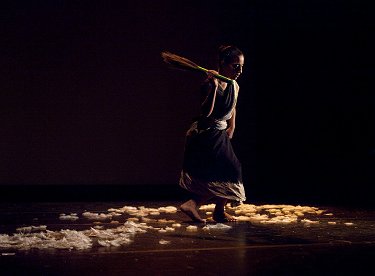 Sheetal
Gandhi in "Bahu-Beti-Biwi"
Sheetal
Gandhi in "Bahu-Beti-Biwi"
|
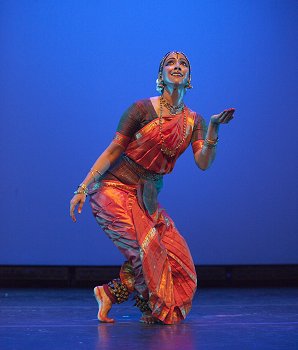 Mythili
Prakash in "Vibha (Lustrous Glory)"
Mythili
Prakash in "Vibha (Lustrous Glory)"
|
The second panel,
'Mathematics of Rhythm II,' explored the Carnatic and Hindustani systems
of tala and its application to Bharatanatyam and Kathak, respectively.
Jonathan Singer began with a brief overview of basic rhythms and sub-rhythms
on the mridangam. Mythili Prakash then demonstrated alternations
in a basic adavu's cadence when the gati is changed, and then she
broke down the structure of a trikala jati. Prerana Desphande emphasized
the main difference between both styles of dance and music in an elaborate
discussion of samam (first beat of a tala cycle). The session ended
with an incisive presentation on mathematics in Bharatanatyam by Smriti
Jain that was conducted over Skype.The day concluded
with an evening of performances by Mythili Prakash, Mesma Belsare, Parul
Shah Dance Company, Sheetal Gandhi, and Ailey II. Mythili's Bharatanatyam
presentation, 'Vibha - Lustrous Glory,' extolled the guru's divine light
of knowledge. 'Surya,' based on verses from the Aditya Hridaya Slokam,
described the sun god as the visual symbol of guru whose pervasive rays
illuminate the universe and sustain the Earth. She also danced with abandon
to a Sufi poem, "Khuda Ki Tasveer," in which the guru is perceived not
only as a spiritual guide but also as a physical manifestation of god.
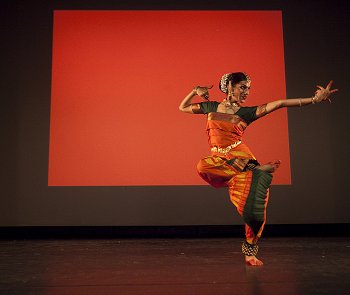 Mesma
Belsare in "Chaurapanchasika"
Mesma
Belsare in "Chaurapanchasika"
|
Mesma then presented
two contrasting pieces - "Chaurapanchasika" and "Akshah (Axis)." The former
was a Bharatanatyam adaptation of a 12th-century Sanskrit poem on forbidden
love that was heart-felt but marred by a distracting slideshow of miniature
paintings in the background. The latter piece was done in collaboration
with Carnatic vocalist Deepti Navaratna in which Mesma sought to express
abstract music through sattvika abhinaya.For their second
performance, Parul Shah Dance Company presented an excerpt from "Radha
Naval." In this abhinaya piece, Radha recalls Krishna's mischief during
Holi as she eagerly waits for his arrival. Parul's portrayal of Radha in
various moods in the piece was subtle and aesthetic.
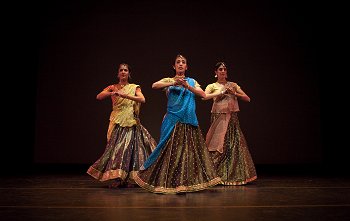 Parul
Shah Dance Company in "Radha Naval"
Parul
Shah Dance Company in "Radha Naval"
|
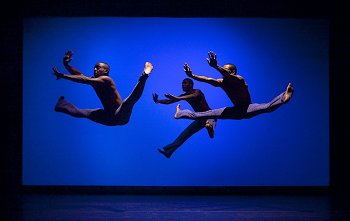 Ailey
II in 'Takademe'
Ailey
II in 'Takademe'
|
Another highlight
of the festival was Sheetal Gandhi's 'Bahu-Beti-Biwi (Daughter-In-Law,
Daughter, Wife)' which combined dance, percussive text, and vocalization
to great effect. The piece was an incisive commentary on the traditional
role of Indian women, and it was offset by brilliant touches of humor.
Also noteworthy were her renditions of Rajasthani and Punjabi folk songs.Ailey II's
concluding performance, 'Takademe,' was a concise modern American dance
composition set to Sheila Chandra's score with sollukattu. It was
not a typical group fusion piece in that its intention was to keep modern
dance distinct from Indian dance. Instead, choreographer Robert Battle
deconstructed the score's complex Indian rhythm and then choreographed
dynamic modern dance movements that matched the music. Sunday,
June 6
The last day
was quite leisurely as it consisted of an innovative workshop led by Paula
Cole followed by a panel discussion and an informal "cushion concert."
Originally conceived by Dr. Richard Schechner, the 'Rasa Boxes' workshop
was a series of fun exercises that incorporated rasa theory into
American performance technique. Participants were challenged to tap into
the eight rasas, as described in the Natya Shastra, without separating
acting, movement, and voice modulation in the overall experience of an
emotional state.
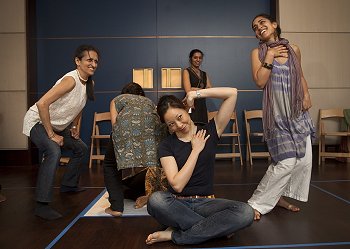 Rasa Boxes
workshop
Rasa Boxes
workshop
|
The second session
was 'Moving Traditions,' a lively panel discussion with Dr. Richard Schechner,
Navtej Johar, Anita Ratnam, and Chitra Sundaram. They discussed the changes
in the systems of learning and patronage for Indian dance. The idea of
changing tradition was introduced by Dr. Schechner in his lucid discussion
of several South Indian counter-narratives of the Ramayana. The moderator,
Purnima Shah, then asked the panelists to comment on the shift from the
guru-shishya parampara tradition of learning to the dance institutions.
Anita stated that the mushrooming of dance schools was the result of widespread
patriotism and the desire to fabricate a national identity centered on
culture. Navtej then added that an intimate bond between teacher and student
was still needed to kindle the spirit to dance.Purnima's second
question to the panelists was on the current ways in which to fund Indian
dance. Chitra responded with an overview of British dance companies specializing
in Indian dance. Interestingly, Indian dance is consciously marketed as
part of British culture, and the British Council allocates funding to Indian
dance companies based on region. However, Anita discussed alternate funding
sources such as dance performances in the private/corporate sector and
the "business of Bharatanatyam" (workshops, lecture-demonstrations, master
classes, arangetrams, etc.).
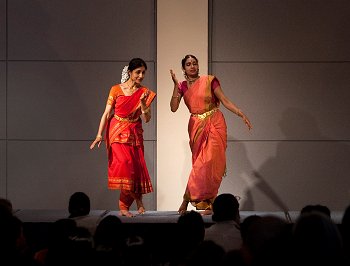 Anuradha
Nehru & Ramya Ramnarayan in "Palukute Nelatali" from Kutcheri-Mehfil
Anuradha
Nehru & Ramya Ramnarayan in "Palukute Nelatali" from Kutcheri-Mehfil
|
The final performance
was an intimate 'Kutcheri-Mehfil,' and the room was filled with soft cushions
upon which the audience reclined while watching abhinaya pieces.
After Chitra's excellent introduction to abhinaya, Anuradha Nehru
presented a javali, "Parulanna Maata" (Kapi; Rupakam; Dharmapuri
Subbrayar) in which the heroine pleads with her obstinate lover to not
listen to idle gossip. Bharatanatyam dancer Ramya Ramnarayan performed
a Sangam era Tamil poem depicting a strong-willed woman dutifully sending
her father, husband, and young son off to war. Anuradha and Ramya then
performed Annamancharya's charming padam, "Palukute Nelatali" (Karnataka
Devagandhari; Khanda Chapu), to live music by Deepti Navaratna.
 Prerana
Desphande from Kutcheri-Mehfil
Prerana
Desphande from Kutcheri-Mehfil
|
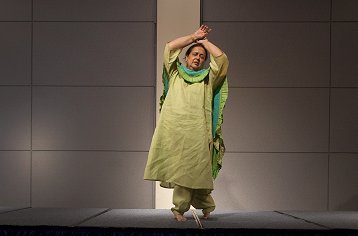 Rachna
Sarang from Kutcheri-Mehfil
Rachna
Sarang from Kutcheri-Mehfil
|
Kathak's subtle
abhinaya was highlighted in the performances of Prerana Deshpande
and Rachna Sarang. The beauty of Vrindavan on the banks of the Yamuna was
vividly described in Prerana's interpretation of "Vrindavana Dham…" Likewise,
Rachna Sarang portrayed Meerabai's fervent devotion to Krishna in the bhajan,
"Shyama Baso." The duet between Rachna and Prerana was fantastic in that
the two dancers seamlessly alternated their depictions of a virahotkhandita
nayika. They were accompanied by Astha Shukla (Hindustani vocalist),
Amod Dandawate (tabla), and Indrajit Roy-Chowdhury (sitar). The kutcheri
ended with a surprise - an impromptu performance of a ghazal by Rachna,
Navtej Johar, and several other participants!Even though
"Erasing Borders" is still a young dance festival, it is undoubtedly an
important global platform for Indian dance. It was professionally managed
by Prachi Dalal with the help of numerous volunteers from both the Indo-American
Arts Council and the Asia Society. Moreover, the festival benefitted tremendously
from an enviable venue, a fine roster of artists, and a diverse audience.
Given these factors, there is no doubt that 'Erasing Borders' will become
a permanent fixture in New York City's dance scene and one of America's
most prestigious dance festivals
Kiran Rajagopalan
is a Chennai based Bharatanatyam dancer originally from the United States.
He is a disciple of A Lakshman and Sujatha Srinivasan. Although he
holds a BA (Honors) in Neuroscience and Spanish, he has chosen to follow
his passion for dance. Kiran finished his MA in Bharatanatyam from Madras University in April 2010. |

